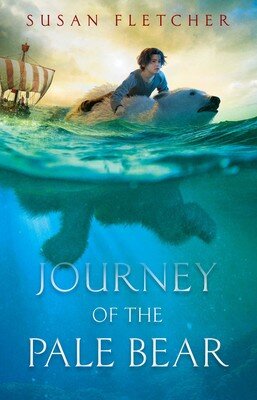Guest Post: Susan Fletcher on Journey of the Pale Bear
Susan Fletcher's prose is glorious, and the history behind her middle grade novel, Journey of the Pale Bear (Margaret K. McElderry Books, October 2018) is fascinating. But the beating heart of this story is a deeply felt friendship between a boy and a bear, under circumstances both breathtaking and improbable. I asked Susan to write about how she built that relationship, how she made it so alive and so compelling. Here's what she wrote:
Here's what she wrote:
It started with the bear. I had read Daniel Hahn’s The Tower Menagerie and was taken with the exotic animals that lived in the menagerie in the Tower of London, beginning in medieval times. And the animal that kept coming back to me was the bear, apparently a polar bear, a gift from the king of Norway. The thing about the bear was…they let her out of her cage! They let her swim and catch fish in the Thames River. Though I was fascinated by many of the menagerie animals—the elephant, the leopards, the porcupine—it was the bear who captured my imagination.As part of my research I contacted the Oregon Zoo, where I met, up close, the resident brother-and-sister polar bears: Conrad and Tasul. Conrad (the male) was enormous (1500 pounds!), and had a commensurately big and goofy personality. I really fell for Conrad. But the polar bear in my book was going to be young, and young male polar bears are some of the most dangerous animals on the planet, making friendship with a boy unlikely.I decided that my polar bear would be a female, maybe separated from her cubs, and that there would be a bit of mother-cub vibe between her and my protagonist, Arthur. In fact, without realizing it, I had already put some of that vibe in the early drafts. Right from the get-go, Arthur hums to the bear. I found out later that polar bear cubs do a sort of humming thing with their mothers. There was also an early scene where the bear reaches out a paw to make contact with Arthur. I found out later that mother polar bears do this with their cubs.So, what about Arthur?He is a runaway, missing his mother, of course. He is out of place in some way; he doesn’t quite fit the world in which he finds himself. He is cut off from his family, unprotected. I kept discovering echoes between Arthur and the bear. They are both strangers in the world in which they find themselves. They are isolated and lonely. They long for freedom, and home. In a way, they need each other.In the 13th century, people didn’t feel as we do about animal rights. I wanted Arthur to bond with the bear, but he still had to be a boy of his times. One of the challenges of the book was to believably take Arthur from a place where a wild animal in a small cage is not a moral issue…to a place where he believes that caging this bear for the rest of her life would be cruel and wrong.And finally, I thought about all the animals I have lived with and loved since childhood: a parade of dogs and cats and birds. Somehow, without words, we understood one another. We had relationships—friendships, actually—each unique. So I tried to think, concretely, about how these friendships worked, and to bring that to the page, as well.
Susan, you do that and more. Congratulations on this beautiful book.